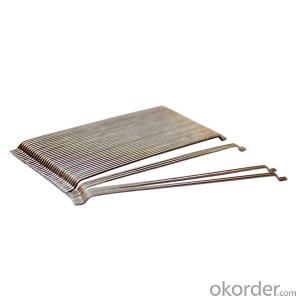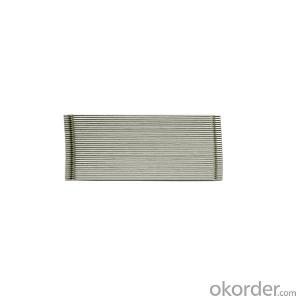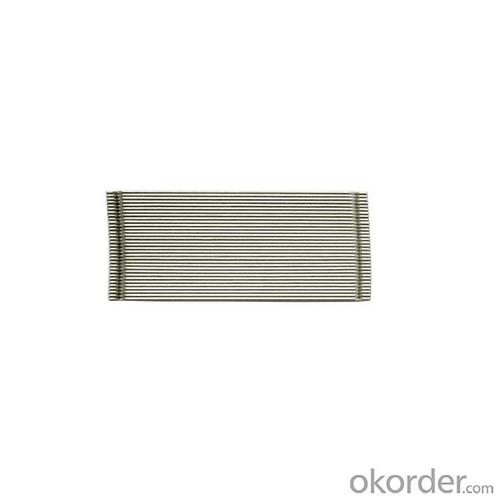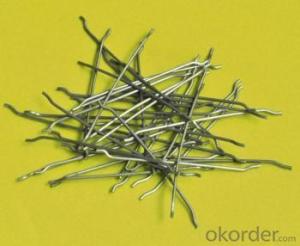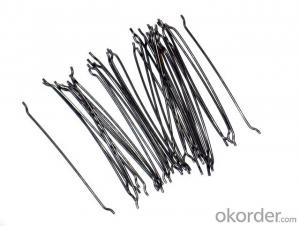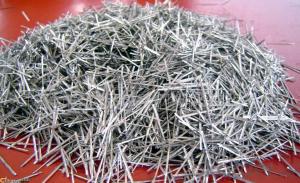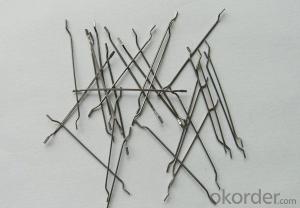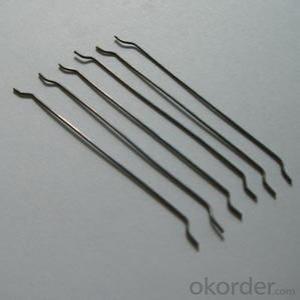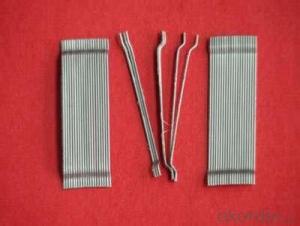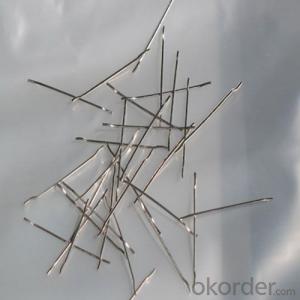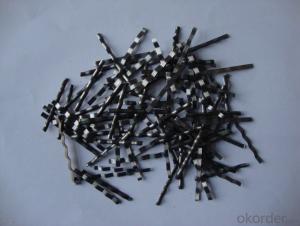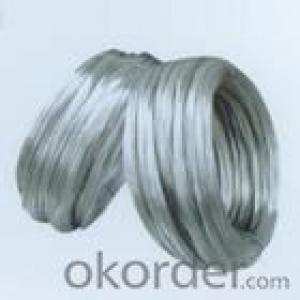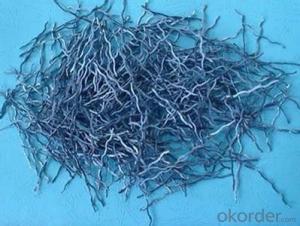Melt Extract Stainless Steel Fiber Glued Steel Fiber from CNBM China
- Loading Port:
- Tianjin
- Payment Terms:
- TT OR LC
- Min Order Qty:
- 1 m.t.
- Supply Capability:
- 5000 m.t./month
OKorder Service Pledge
Quality Product, Order Online Tracking, Timely Delivery
OKorder Financial Service
Credit Rating, Credit Services, Credit Purchasing
You Might Also Like
Quick Details
Place of Origin: Tianjin, China (Mainland)
- Model Number: 0.9
Material: Steel
Production Process: Cold drawn
Lengh: 60
Type: 1
Compressive Strength: >1200MPa
Aspect ratio: 66
Standard: ASTM A820M-11
Section Shape: Circular
Application: Concrete Reinforcement
Packaging & Delivery
| Packaging Details: | 20 kg/Bag,50 bags/Pallet or 1,000kg/ Bulk Bag |
|---|---|
| Delivery Detail: | 1 Month |
Product Description
| Diameter | 0.75 mm | ||
| Length | 60 mm | ||
| Aspect Ratio | 80 | ||
| Tensile strength | 1200 MPa | ||
| Type | Cold drawn Steel Fiber | ||
| End | Hooked-end Steel Fiber | ||
| Glued/Loose | Glued Steel Fiber | ||
| Bending Angle | 45°(min.30°) | ||
| Usage & Performance | Floor:Trafficked areas and Industrial floors | ||
| Shotcrete :Slope stabilization and Final lining | |||
| Precast concrete:Pipe and Railway sleepers | |||
| Packing | Standard Export Pallet Packing | Bag Packing | 20 kg/Bag,50 bags/Pallet |
| Bulk Packing | 1,000kg/ Bulk Bag | ||
| Loading Quantity | 20’GP | 20-25 Tonne/Tonnes | |
| 40’GP | 25-27 Tonne/Tonnes | ||
| 40’HQ | 25-27 Tonne/Tonnes | ||
| MOQ | 1 kg for trial order | ||
| Supply Ability | 10,000 Tonne/Tonnes per Year | ||
| Payment Terms | T/T or L/C at sight | ||
| Delivery Time | Within 15 days after receiving deposit or original L/C at sight | ||
| Certification | ISO9001:2000, CE, | ||
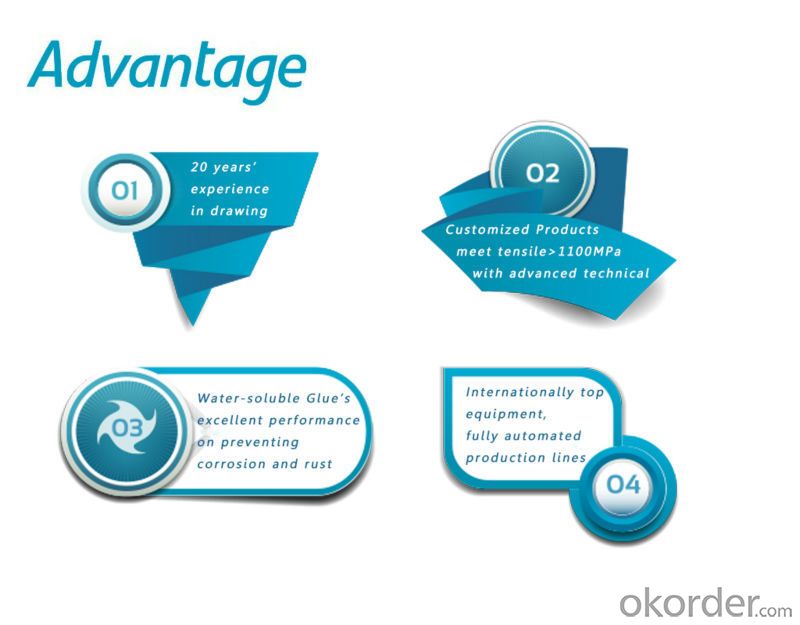
| Product | Diameter (mm) | Length (mm) | Aspect Ratio | Type | Packing |
| G-6030 | 0.5 | 30 | 60 | Glued | 20 kg/Bag, or 1,000kg/ Bulk Bag |
| G-6535 | 0.55 | 35 | 65 | Glued | 20 kg/Bag, or 1,000kg/ Bulk Bag |
| G-6035 | 0.6 | 35 | 60 | Glued | 20 kg/Bag, or 1,000kg/ Bulk Bag |
| G-8060 | 0.75 | 60 | 80 | Glued | 20 kg/Bag, 50 bags/Pallet |
| G-6060 | 0.9 | 60 | 60 | Glued | 20 kg/Bag, 50 bags/Pallet |
| G-6030 | 0.5 | 30 | 60 | Loose | 20 kg/Bag, or 1,000kg/ Bulk Bag |
| G-6535 | 0.55 | 35 | 65 | Loose | 20 kg/Bag, or 1,000kg/ Bulk Bag |
| G-6035 | 0.6 | 35 | 60 | Loose | 20 kg/Bag, or 1,000kg/ Bulk Bag |
| G-8060 | 0.75 | 60 | 80 | Loose | 20 kg/Bag, 50 bags/Pallet |
| G-6060 | 0.9 | 60 | 60 | Loose | 20 kg/Bag, 50 bags/Pallet |
- Q: Is melt extract stainless steel fiber compatible with all types of admixtures?
- Melt extract stainless steel fiber is generally compatible with most types of admixtures used in concrete. However, it is important to note that compatibility can vary depending on the specific type and dosage of admixture used, as well as the intended application and performance requirements of the concrete. Stainless steel fibers are typically inert and do not react chemically with most admixtures, which makes them generally compatible. They can be used in conjunction with various types of admixtures such as water reducers, air entraining agents, accelerators, retarders, and superplasticizers. However, it is crucial to consult the manufacturer's recommendations and conduct compatibility tests to ensure that the specific admixture being used is compatible with stainless steel fibers. Some admixtures may have specific guidelines or limitations when it comes to their use with fibers. Admixture manufacturers can provide guidance regarding their compatibility with stainless steel fibers and any potential performance implications. Additionally, it is important to consider the intended purpose of the concrete and the desired properties. Stainless steel fibers can enhance the mechanical properties of concrete, such as its flexural strength, toughness, and durability. However, certain admixtures, such as those designed for specific purposes like corrosion inhibition or shrinkage reduction, may have different requirements or limitations when used in combination with stainless steel fibers. In summary, while melt extract stainless steel fiber is generally compatible with most types of admixtures, it is crucial to consult the manufacturer's recommendations and conduct compatibility tests to ensure optimal performance and avoid any potential issues.
- Q: Can melt extract stainless steel fiber be used in the construction of tunnels?
- Melt extract stainless steel fiber is capable of being utilized in the construction of tunnels. Renowned for its remarkable tensile strength, durability, and resistance to corrosion, stainless steel fiber proves to be an exceptional material for reinforcing concrete structures. When it comes to tunnel construction, incorporating stainless steel fiber into the concrete mixture serves to amplify its structural integrity, bolster crack resistance, and prolong the lifespan of the tunnel as a whole. The fibers work effectively to evenly distribute loads throughout the concrete, thereby diminishing the likelihood of cracks and heightening its capacity to endure external forces like vibrations and ground settlement. Additionally, the corrosion resistance of stainless steel fiber guarantees its ability to withstand the harsh conditions typically encountered in tunnel construction, including exposure to moisture and chemicals. Ultimately, the integration of melt extract stainless steel fiber in tunnel construction yields significant improvements in the sturdiness and longevity of the tunnels.
- Q: Can melt extract stainless steel fiber be used in seismic-resistant concrete structures?
- Yes, melt extract stainless steel fiber can be used in seismic-resistant concrete structures. Stainless steel fibers, including melt extract stainless steel fibers, are commonly used as reinforcement in concrete to enhance its tensile strength, ductility, and durability. In seismic-resistant concrete structures, where the concrete is subjected to significant dynamic loads during earthquakes, the inclusion of stainless steel fibers can significantly improve the overall performance and resistance of the structure. The use of melt extract stainless steel fibers in seismic-resistant concrete structures offers several advantages. Firstly, stainless steel fibers have high tensile strength and excellent ductility, which allows them to effectively distribute the applied forces and resist cracking and deformation under seismic loads. This helps to maintain the integrity of the concrete structure and prevent catastrophic failure during earthquakes. Additionally, stainless steel fibers exhibit excellent corrosion resistance, which is crucial in seismic-resistant concrete structures that may be exposed to harsh environmental conditions, such as high moisture or chloride exposure. The corrosion resistance of stainless steel fibers ensures the long-term durability and structural integrity of the concrete, even in aggressive environments. Moreover, melt extract stainless steel fibers also provide enhanced bond strength between the fiber and the concrete matrix. This improves the overall composite behavior of the concrete and enhances its resistance to shear stresses and cracking, which are common during seismic events. Overall, the use of melt extract stainless steel fiber in seismic-resistant concrete structures is a viable and effective solution to enhance their structural performance and durability. It helps to improve the tensile strength, ductility, and corrosion resistance of the concrete, ensuring its ability to withstand the dynamic forces and deformations associated with earthquakes.
- Q: What is the effect of melt extract stainless steel fiber on the workability of asphalt mixtures?
- The effect of melt extract stainless steel fiber on the workability of asphalt mixtures can be significant. Stainless steel fibers are often added to asphalt mixtures to improve their mechanical properties and enhance their overall performance. The addition of stainless steel fibers can increase the viscosity of the asphalt mixture, thereby improving its workability. This increased viscosity allows for better cohesion and binding of the aggregate particles, resulting in a more stable and durable asphalt pavement. Furthermore, the presence of stainless steel fibers can improve the resistance of the asphalt mixture to cracking and rutting. These fibers act as reinforcement, providing additional strength and preventing the propagation of cracks. This can extend the lifespan of the asphalt pavement and reduce the need for frequent repairs and maintenance. Additionally, the use of stainless steel fibers can enhance the resistance of asphalt mixtures to deformation and rutting caused by heavy traffic loads. This can be particularly beneficial in high traffic areas where the asphalt pavement is subjected to significant stress and strain. However, it is important to note that the effect of melt extract stainless steel fibers on the workability of asphalt mixtures can also depend on various factors such as the fiber content, fiber length, and mixing process. Therefore, proper design and testing are necessary to ensure that the addition of stainless steel fibers does not adversely affect the workability of the asphalt mixture. In conclusion, the addition of melt extract stainless steel fibers to asphalt mixtures can have a positive impact on their workability. It can improve the viscosity, cohesion, and overall mechanical properties of the mixture, leading to a more durable and long-lasting asphalt pavement.
- Q: Can melt extract stainless steel fiber improve the ductility of concrete?
- Concrete can have improved ductility with the incorporation of melt extract stainless steel fiber. These fibers are added to concrete mixtures to enhance its mechanical properties and performance under different loading conditions. By increasing the flexibility and strength within the concrete matrix, the stainless steel fibers act as reinforcement. They help distribute the load and prevent cracks from spreading when the concrete experiences tensile stresses, reducing the risk of failure. Additionally, the addition of these fibers improves the impact resistance and durability of concrete, making it more suitable for applications with heavy loads or dynamic forces. To conclude, the utilization of melt extract stainless steel fiber can effectively enhance the ductility of concrete by increasing its resistance to cracks and allowing it to deform without fracturing.
- Q: Can melt extract stainless steel fiber replace traditional reinforcement methods in concrete?
- Yes, melt extract stainless steel fiber can potentially replace traditional reinforcement methods in concrete. Melt extract stainless steel fibers are made from high-quality stainless steel, which provides excellent resistance to corrosion and high tensile strength. These fibers can enhance the mechanical properties of concrete, improve its durability, and increase its resistance to cracking and impact. Compared to traditional reinforcement methods such as steel bars or wire mesh, stainless steel fibers offer several advantages. Firstly, they are easier to handle and install, as they can be simply added to the concrete mix during batching. This eliminates the need for labor-intensive installation of steel bars or wire mesh, saving time and effort. Additionally, the use of stainless steel fibers eliminates the risk of corrosion, which is a common issue with traditional reinforcement methods. Corrosion can significantly reduce the lifespan and strength of concrete structures. Stainless steel fibers, on the other hand, are highly resistant to corrosion, ensuring the longevity and durability of the concrete. Moreover, melt extract stainless steel fibers can improve the overall performance of concrete. They enhance the flexural and tensile strength of the material, making it more resistant to cracking and deformation. This is particularly beneficial in applications where concrete is exposed to heavy loads or dynamic forces, such as in industrial flooring, bridge decks, or airport runways. In summary, melt extract stainless steel fiber can be a viable alternative to traditional reinforcement methods in concrete. Its corrosion resistance, high tensile strength, and ease of installation make it an attractive option for enhancing the performance and durability of concrete structures. However, the specific application and design requirements should be carefully considered before deciding on the suitability of using stainless steel fibers as a replacement for traditional reinforcement methods.
- Q: What is the effect of melt extract stainless steel fiber on the crack width in shotcrete?
- The crack width in shotcrete is significantly affected by the use of melt extract stainless steel fiber. Stainless steel fibers are renowned for their exceptional tensile strength and durability, making them the ideal reinforcement material for shotcrete applications. Upon addition to the shotcrete mix, the stainless steel fibers are uniformly dispersed throughout the material, forming a reinforcement network that enhances its structural integrity. This reinforcement effectively reduces crack width in the shotcrete by bridging the cracks and preventing their propagation. The melt extract stainless steel fibers serve as micro-reinforcement within the shotcrete, amplifying its ductility and resistance to cracking. This is especially advantageous in areas with high stress concentrations or where cracking is prevalent, such as tunnels, underground structures, or retaining walls. By diminishing crack width in shotcrete, the utilization of melt extract stainless steel fibers enhances the material's overall durability and longevity. It elevates its ability to withstand environmental factors, including freeze-thaw cycles, chemical exposure, or mechanical loading, all of which can trigger crack propagation and subsequent deterioration. Moreover, the reduced crack width in shotcrete also enhances its aesthetic appearance by minimizing visible indications of cracking on the surface. This is particularly crucial in architectural applications where the shotcrete is exposed and serves as a decorative element. To summarize, the incorporation of melt extract stainless steel fibers into shotcrete yields positive effects on crack width in the material. It enhances structural integrity, durability, crack resistance, and overall aesthetic appearance, rendering it a valuable reinforcement option for shotcrete applications.
- Q: What is the effect of melt extract stainless steel fiber on the autogenous shrinkage of concrete?
- The melt extract stainless steel fiber has a significant effect on reducing the autogenous shrinkage of concrete. Autogenous shrinkage refers to the inherent self-desiccation and subsequent volume reduction of concrete due to the hydration process. When stainless steel fibers are added to concrete, they create a three-dimensional reinforcement network within the matrix. This network helps to enhance the overall tensile strength and ductility of the concrete. Additionally, the stainless steel fibers act as micro-reinforcements, preventing the formation and propagation of cracks during the early stages of concrete hydration. By reducing the formation of cracks, the stainless steel fibers minimize the potential for moisture loss from the concrete. This, in turn, reduces the autogenous shrinkage. The stainless steel fibers act as a barrier, hindering the evaporation of water from the concrete and maintaining a higher moisture content within the matrix. Moreover, the melt extract stainless steel fibers have a higher aspect ratio and better dispersion compared to other types of fibers, such as polypropylene or carbon fibers. This improved dispersion ensures a more uniform distribution of the fibers throughout the concrete, further enhancing their effectiveness in reducing autogenous shrinkage. Overall, the addition of melt extract stainless steel fibers to concrete significantly reduces the autogenous shrinkage by preventing crack formation and minimizing moisture loss. This results in a more durable and crack-resistant concrete structure.
- Q: What is the recommended fiber dosage when using melt extract stainless steel fiber in shotcrete?
- The recommended fiber dosage when using melt extract stainless steel fiber in shotcrete varies depending on the specific project requirements and the desired performance characteristics. However, a general guideline for the fiber dosage in shotcrete is typically in the range of 20 to 40 kilograms per cubic meter (kg/m3) or 1.2 to 2.4 pounds per cubic yard (lb/yd3). This dosage range provides sufficient reinforcement and enhances the overall durability, crack resistance, and impact resistance of the shotcrete. It is important to consult with the manufacturer or a qualified engineer to determine the exact fiber dosage based on the specific project needs and requirements.
- Q: Can melt extract stainless steel fiber be used in pipeline construction?
- Melt extract stainless steel fiber is suitable for pipeline construction. It possesses exceptional qualities such as high tensile strength, resistance to corrosion, and durability. These attributes make it an excellent choice for reinforcing concrete and other construction purposes, including pipeline construction. The inclusion of stainless steel fibers in the concrete mixture improves its ability to resist cracks and enhances its overall structural strength. This is particularly advantageous in pipeline construction, as pipelines are exposed to various environmental factors and stresses. Additionally, melt extract stainless steel fibers can help prevent cracks and subsequent leakage in pipelines, ensuring their long-term reliability and functionality. Therefore, incorporating melt extract stainless steel fiber in pipeline construction effectively enhances the performance and lifespan of the pipelines.
Send your message to us
Melt Extract Stainless Steel Fiber Glued Steel Fiber from CNBM China
- Loading Port:
- Tianjin
- Payment Terms:
- TT OR LC
- Min Order Qty:
- 1 m.t.
- Supply Capability:
- 5000 m.t./month
OKorder Service Pledge
Quality Product, Order Online Tracking, Timely Delivery
OKorder Financial Service
Credit Rating, Credit Services, Credit Purchasing
Similar products
Hot products
Hot Searches
Related keywords
